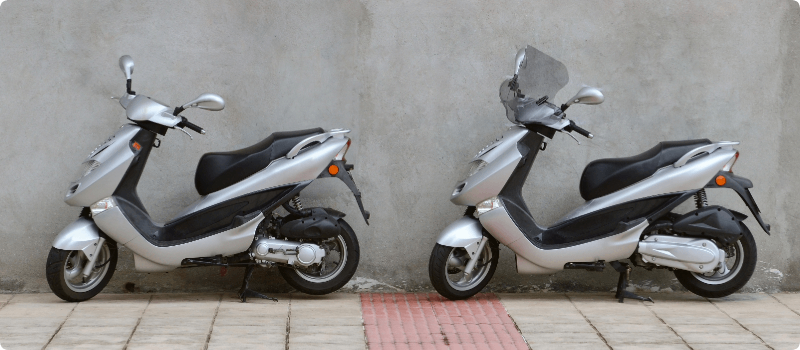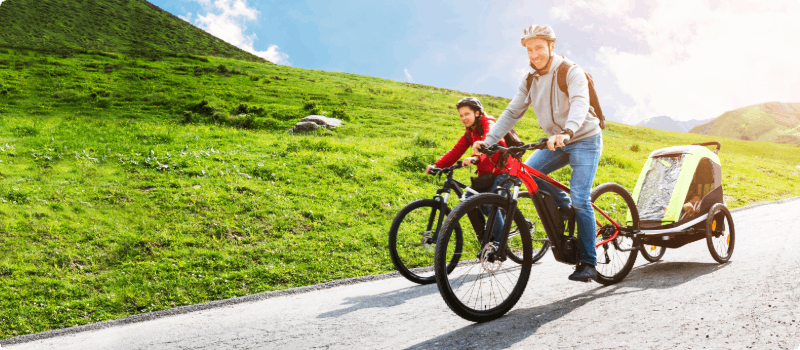E-bike vs. moped vs. scooter
Updated June 2, 2021 . AmFam Team
Updated June 2, 2021 . AmFam Team
Are you in the market for a moped, scooter, or electric bike (e-bike) but not sure which route to go? With all the options to choose from, it’s important to take the time to find which bike is the right ride for you. That’s where we come in. We’re here to help you get everything you need to know about mopeds, scooters, and e-bikes to make a smart choice.
Whether you’re looking to breeze around campus, or zip from A to B on two wheels, take a close look at this primer to get in the know on the wide array of e-bike, scooter, and moped facts.

A moped is a bicycle-type vehicle with pedals and an engine that's less than two horsepower. Mopeds, or motor pedals, get their name from the bicycle pedals the rider uses to start the motor. Moped engine sizes are measured by cubic centimeters (cc) and are designed to help riders with pedaling and to supply some power. Even though most mopeds come with an electric system, some still use pedals.
Mopeds with gas engines, or internal combustion engines, make pedaling easier for the rider. There are some mopeds with electric engines, but most are gas-powered.
The average moped has an engine under 50cc and can reach top speeds of 28 miles per hour (mph). A moped’s top speed is far slower than a motorcycle’s, which makes them best suited for city streets.
Power and size are two important factors that distinguish mopeds from motorcycles. Motorbikes with engines smaller than 50cc are considered mopeds and a motorcycle is anything with an engine over 250cc.
Mopeds are ideal for short trips at low speeds. It’s a step above a bicycle speed-wise and is far less expensive than a motorcycle. Here are some more key benefits of a moped.
Gaining fame in the early 1950’s, mopeds offered a reliable means of travel for people with limited budgets. And they still fill that niche today.
Today’s models are much safer and more fuel-efficient than earlier models. Because they’ve got time on their side, they’ve gained from a long history of design upgrades.
Mopeds are considered to be motor vehicles in many areas. Some states require riders to have an operator’s license, tags and moped insurance. Check with your local DMV and learn about your state’s moped laws.
Typically costing more up-front, a new moped can get pricey when compared to an E-bike. Costly items like shock absorbers and automatic braking systems can add a level of safety.
Because they are considered a motorized vehicle, registration, driving school and gas costs all factor into a higher yearly expense when compared to an electric bike.
If your moped is over 50cc, the bike will be deemed a motorcycle in many states. If it is, don’t forget to review our options for motorcycle coverage.
While people are still buying mopeds, many new arrivals in the e-bike market are getting noticed. Mopeds are the tried-and-true option for getting around town, but they can limit your ability to see the sites in ways that only an e-bike can offer.

E-bikes are bikes with motors that help you pedal, so riding is easier. Motors on bikes are powered by rechargeable batteries. There are bike models that need your help pedaling while others move forward by themselves with a motor. A variety of modes can be used to balance pedal power with range and battery life on electric bikes.
Fast, energy efficient and taking the market by storm, electric bikes are here to stay. Well-built apps get you key details on your bike. Better still, you can ride off-road legally with them, too. In the early 2000’s, electric bikes started to gain momentum, and since then, they’ve only grown in popularity.
Here are some other important details to keep in mind when considering an E-bike.
This simple feature has made them even more popular. If you want the chance to exercise while zipping around town, e-bikes are the way to go.
E-bikes don’t require gas to get around as mopeds require. This makes them a good choice of transportation for those who want to decrease their carbon footprint.
New high-efficiency lithium-ion batteries are increasing both bike speed and ride time. As money for research and development continues to be poured into renewables, electric bike batteries are improving.
With speeds topping out around 22 mph, that may not be fast enough if you’ve got a long commute. Some high-end e-bikes do get up into the 30-mph range, but most don’t.
State licensing and tag processing fees are not usually related to the purchase of an e-bike, making them attractive to people with limited budgets.
Because most states consider e-bikes a bicycle, you’ll be able to legally ride them on the street and trails. This includes paved bike trails that are off-limits to mopeds. E-mountain bikes are also available if your commute includes forest trails or dirt roads.
From great apps that help you navigate, to geo-location info, e-bikes are tech-loaded. Some e-bikes also convert braking and pedaling energy back to the battery. I bet your old bicycle can’t do that!
It’s as simple as finding a bike rack and locking it up. Many e-bikes come with portable battery units that easily detach so you can lock up outside and charge inside.

Like mopeds, scooters have step-through frames, but the biggest difference between them is the size of their engines. The engine size of scooters is not set, which means you can get a scooter that can have a high or a low powertrain that ranges from 50cc to 750cc in size. It’s important to note that the rules for scooters mirror motorcycles when it comes to road safety.
Here are some key things to consider before purchasing that scooter you’ve had your eyes on.
Small, powerful engines and lightweight frames make scooters a great choice for daily commutes and better gas mileage. A scooter with a 150cc powertrain can reach a maximum speed of 60 miles per hour and get up to 70 miles per gallon.
Scooters don’t have limitations on engine size. There are no set engine sizes for scooters, so you can get one with a 50cc to 750cc engine. There are a wide range of scooters out there with engines that are large enough to handle daily commutes.
The wheels of scooters are usually smaller than those on mopeds, and they feature either automatic or manual transmissions. The small engines make them both lightweight and easy to maneuver.
A scooter is usually more expensive than a moped because of the increased power and engine size, engine sophistication, acceleration, and top speed. Scooters feature more power than a moped, but far less than motorcycle.

Characteristics | Scooter | Moped | Motorcycle | E-bike |
|---|---|---|---|---|
What is it? | A two-wheeled vehicle with a step-through chassis and footrest platform | A bicycle-type vehicle (or two-wheeled vehicle) with a low-powered engine and pedals the rider uses to propel it to start | A two-wheeled vehicle with no pedals that can reach far higher speeds than a scooter, moped, or e-bike | A motorized bicycle with an integrated electric motor that assists propulsion |
Engine size | 50cc - 250cc | 50cc | 250cc or larger | 250w – 1500w |
Wheel size | 10” - 16” | Varies | 16” or larger | 16” – 26” |
Speed | Varies by engine size | 28 miles per hour | Varies by engine size | Varies by wattage |
Legal to ride on the highway? | Yes | No | Yes | Varies by state* |
Age requirement | 14-16 | 15-16 | 16 | 14-to-16 |
Motorcycle license needed? | Yes | Varies by state | Yes | N/A |
Whether you choose a moped, scooter, e-bike or motorcycle, you want to make sure your investment is protected. Reach out to an American Family Insurance agent and find out what policy can best protect your two-wheeler. There’s nothing like cruising around town with the confidence that your new ride is properly insured.
This article is for informational purposes only and includes information widely available through different sources. This article does not afford, offer, or guarantee any coverage.